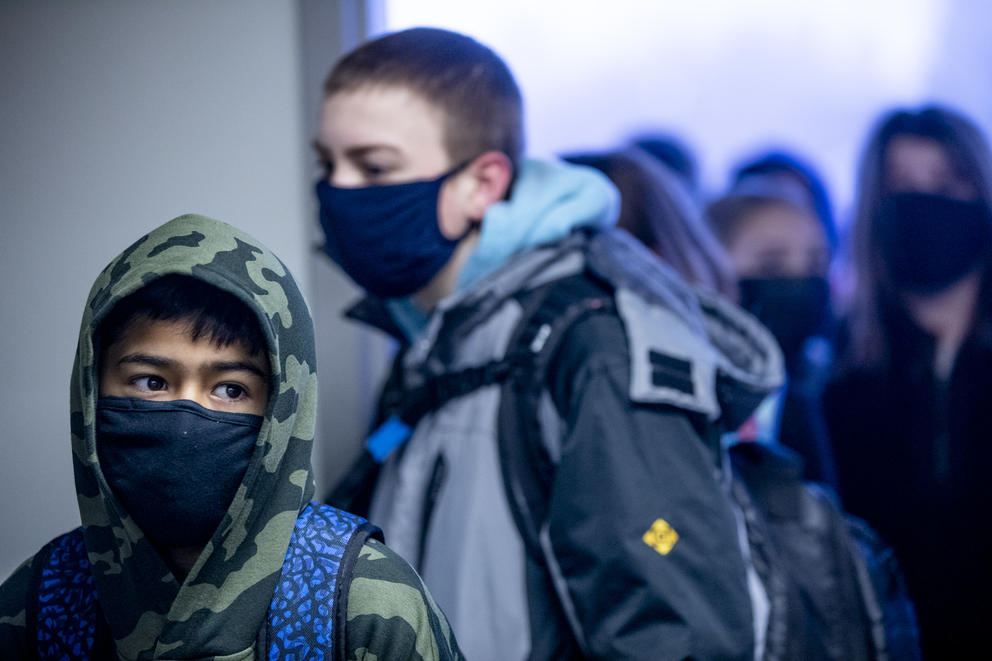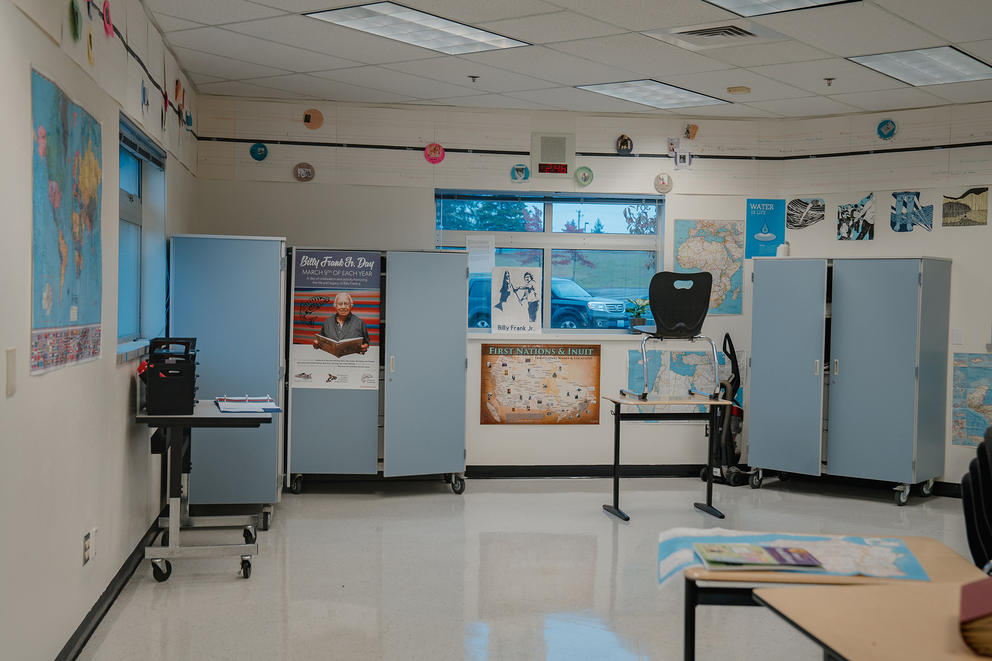“My son always presents as very outgoing and chats a lot and has a very sunny disposition,” says Liz, who chose to withhold her last name to protect the identity of her son, a junior in a Bellevue School District high school. “As a parent, I thought, ‘Oh, he's not depressed. He chats and tells me how things are going.’ ”
But when her son was screened through Bellevue School District’s Mental Health Assistance Team during the fall of 2019 she learned he wasn’t doing well. He scored high for depression, anxiety and suicidal ideation. Bellevue’s MHAT program is used to screen all 10th graders, who are then referred by teachers and counselors if they score a certain level for the three conditions.
“I’m so thankful he had that screening and that resource was available. I just can’t imagine if that hadn’t happened,” Liz says.
Liz's son benefitted from an expansion of mental health support in Washington public schools that was taking place even before the pandemic. With the added pressures of 2020, that support has become even more critical.
Schools in Washington state were among the first in the country to pivot to virtual learning at the beginning of the pandemic last March. Alongside that disruption also came widespread economic uncertainty and major social isolation, as well as the coronavirus’ rising death toll. School counselors say the shift into pandemic life created an immediate call to arms, both because of the stress of virtual school and everything else young people are dealing with right now, at home and out in the world.
Few studies and surveys have thoroughly analyzed the mental health impacts of the pandemic on children and youth, but early available research reveals a crisis. A survey conducted by YoungMinds, a U.K.-based mental health charity, found that 83% of the 2,111 youth participants with previous mental health challenges said the pandemic had made their conditions worse. An Active Minds survey of 3,239 high school and college students found that 74% of students are struggling to keep a routine and that eight in 10 students are struggling with focus and avoiding distractions.
Multiple bills introduced during Washington state's current legislative session address mental health in schools and aim to bolster school counseling programs further.
After Liz’s son’s screening in fall 2019, a counselor reached out to her, and her son was promptly connected with services that are integrated into his school. When the pandemic began, his check-ins went virtual. Liz says because he had gotten help before the school went virtual, her son had no trouble staying in touch with his counselors.
“I’m really glad he had that going into COVID, I haven’t even thought about what COVID would have been like without that support,” Liz says, choking up over the phone.
Some of the challenges that come with online education — a lack of engagement and participation — are similar to the issues counselors see when they try to provide students with mental health help. School mental health specialists have found the virtual pivot to be at least as difficult for teachers as for students, especially because depression in and of itself pushes people to withdraw.
“Because [the switch to remote school] happened so quickly, there were a lot of adjustments … trying to figure out how we are going to do counseling with kids online; Are they going to show up? How authentic is it going to be?” says Kerince Bowen, Bellevue School District’s director of counseling. “Initially that was the big concern: how to get the kids to participate?”
So far, Bowen and other counselors have noticed, specifically with their MHAT program, that there are indeed far fewer tenth graders screening than in years past. Since students aren't answering the questions, MHAT counselors are struggling to identify which students need help. To some extent, she says, chuckling, counselors are borderline harassing students in order to check in on their mental well-being.
“It’s easier for kids to not check in because all they have to do is not log in and there's not much we can do,” Bowen says. “When you’re in a building you just walk down to the classroom and say, ‘Hey, come with me.’ They don’t really have much of a choice.”
Bowen says school mental health issues have many layers. First, the virtual nature of school is leading students to withdraw, even when they may or may not need extra help with their mental health. Additionally students avoid turning on their cameras, in class and in counseling, which makes it difficult for teachers and counselors to observe their behavior and read their body language, which could signal other issues. Learning from home also doesn’t offer the confidentiality and privacy that counseling offices usually provide when talking about sensitive topics around emotional and psychological struggles.
Georganna Sedlar, a consultant for Bellevue School District’s MHAT program, has been wondering, even worrying, about the many ways the pandemic has impacted the social and emotional development of children and youth.
Sedlar is a licensed clinical psychologist and an assistant professor in both the University of Washington’s departments of psychiatry and behavioral sciences and the department of psychology. She says teens in particular are at a pivotal moment in their lives — developing their sense of being, forming their identities and oftentimes dealing with the awkward and angsty stage of adolescence.
Instead of getting feedback from their friends and social circles in person, everything this past year has become intensely digitally centered. She worries about students' overreliance on social media for connection and sense of worth, while those platforms have proven negative effects on teens’ self-esteem.
The list of emotional and psychological stressors do not end there.
“We have to appreciate that kids don’t exist in vacuums. They’re part of multiple systems and families,” Sedlar says. The other layers of the stress for youth include the impact COVID-19 has on parents, including financial stress and unemployment and the stress of working during the pandemic. Those stressors can be magnified when race is taken into account, she added.
“It’s profound just thinking about how kids are making sense of everything in their world,” Sedlar says.
On top of holding bilingual online community forums to educate parents on depression and anxiety and offering some in-person mental health services, Bellevue School District also partners with Youth Eastside Services to provide therapy to students.
Kristie Neklason, YES’s director of school-based behavioral health, says when schools pivoted to online, so did YES. Overnight, it felt as though the connection between therapists and students was abruptly cut. Even though those bridges have slowly been rebuilt, Neklason says she knows it’s only the beginning, and students will need additional resources whenever schools pivot back to in-person instruction.
“We can't have kids coming back and not identifying what's going on with them,” she says. “There's going to be a huge spectrum when they come back, and we need to get ready and have the resources for that.”
As far as Bowen, the Bellevue School District director of counseling, can tell, the district is one of the few in Washington that offers a comprehensive and proactive counseling program like MHAT. According to a statewide survey of 329 school counselors conducted by the Washington State Counselor Association in March of 2019, nearly 84% of counselors surveyed said they could not adequately care for the mental health needs of their students.
This year, multiple bills have been introduced in the legislative session aimed at improving schools counseling programs and mental health resources. House Bill 1444, for example, would provide trauma counseling to students impacted by the pandemic, while HB 1373 would require school districts to make mental health resources more prominently visible on their campuses, websites and social media.
Senate Bill 5030, overwhelmingly passed by the Senate, 48-1, on Feb. 23, would require counselors to spend 80% of their time providing actual counseling services and requires districts to implement more comprehensive mental health programs that are aligned with state and national standards.
The walls of history teacher Alison McCartan’s classroom at River Ridge High School in Lacey, Wash., photographed on Thursday, Nov. 12, 2020, features maps, reference posters, and a timeline activity students completed last academic year. After the first two units of the class, McCarten asked students to reflect on the most significant events in Native history and create event cards to add to a physical timeline. The students were able to reach the 1700s on the timeline before the coronavirus pandemic closed in-person learning at the high school. (Jovelle Tamayo for Crosscut)
Representatives of the Washington Office of Superintendent of Public Instruction testified in support of all three bills during committee hearings. While SB 5030 does not include more money to pay for additional counselors, OSPI’s budget requests a phased-in increase in the state allocation for counselors through 2025. Currently the state provides about one full-time counselor for every 800 elementary students, one for every 411 middle schoolers and one for every 236 high schoolers.
“Across the educational spectrum we need more counselors. We needed it before the crisis, but obviously now with the COVID-related need even eclipsing what we saw before, it's clear we need to get more folks into these positions,” says SB 5030 co-sponsor Sen. Marko Liias, D- Lynwood, speaking at a press availability with Democratic leaders.
On Feb. 25, another bill concerning teens and mental health unanimously passed the Senate. SB 5327 would establish a suicide and school shooting tip line. A press release from the bill sponsor, Sen. Sharon Brown, R- Kennewick, points to a report by the Centers for Disease Control and Prevention which shows in November of last year, mental health emergency room visits increased between 24% and 31% among youth ages 5 to 17.
Liz says, nowadays, thanks to the integrated mental health support at her son’s school, she’s learned how to help her teenage son without being invasive, sometimes asking him if it’s a “thumbs up” or “thumbs down” type of day. Despite working at a low-income housing provider and having a background in helping people with behavioural health challenges, Liz says she was completely blindsided as a parent.
“I should have known this,” Liz says, adding that school counselors and the skills they can offer students are indispensable. “It wasn't on my radar at all and that’s something I learned — not to feel so confident that your kid is doing OK just because you think they are doing OK.”
Crosscut political reporter Melissa Santos contributed to this story.
The caption on the photo of the empty classroom at River Ridge High School has been edited to remove a reference to the school's Native history curriculum being one of the first in Washington state. Native history has been taught for centuries by informal community educators, by tribal elders and in state-run schools on tribal lands. In 2015, the Washington Legislature required all schools in Washington to adopt Native education models into their curriculum






